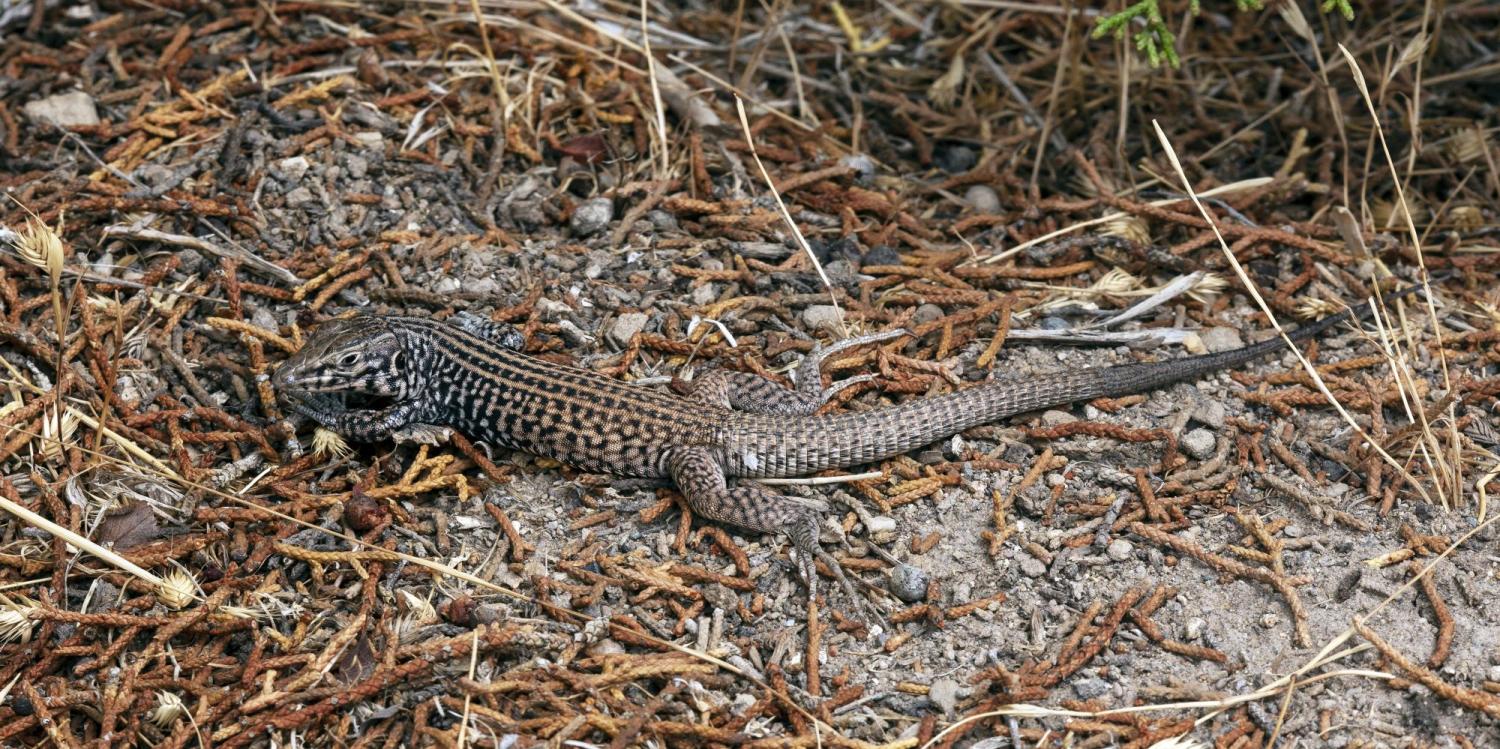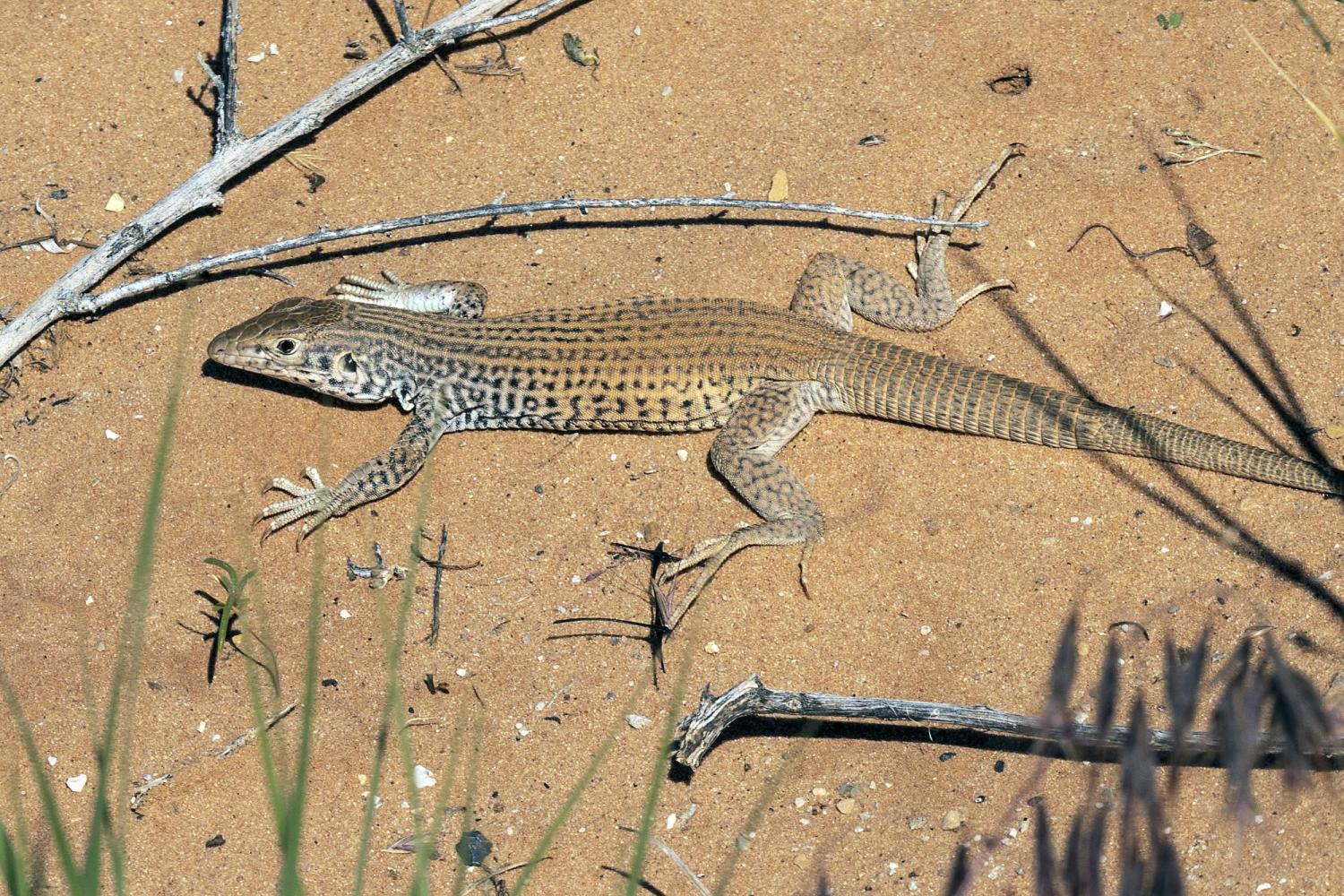Two simple contrasts illustrate how the environments occupied by tiger whiptails differ in fundamental ways
A long slender lizard moved among trees in a pinyon-juniper woodland on the Colorado Plateau, searching the accumulated debris beneath the trees for grubs, spiders, beetles or any other insects. It stopped when it saw a grasshopper, then dashed to get it but the grasshopper escaped into the air. But when it landed the lizard closed in and grabbed it. Unlike many other western lizards which are usually sit and wait predators, whiptails seem to be constantly on the move, using their speed and agility to catch prey that run away or fly short distances.
Tiger whiptails, Cnemidophorus (or Aspidoscelis) tigris, have an enormous geographic range, from Idaho through the Baja Peninsula and from California to western Colorado. This species is called the tiger whiptail because it has light longitudinal stripes along its body. Tiger whiptails occupy the Sonoran, Mojave, and Great Basin Deserts, grasslands, sagebrush prairies and pinyon-juniper woodlands. Adaptations to these varied environments have produced notable differences justifying numerous subspecies.
The subspecies C. tigris septentrionalis occupies the entire Colorado Plateau, including the western edge of Colorado. Five other mainland subspecies and three subspecies on islands near Baja have been recognized to acknowledge geographic variation in color pattern, reproduction and annual patterns of activity.
Two simple contrasts illustrate how the environments occupied by tiger whiptails differ in fundamental ways. In northern environments, whiptail diets are dominated by grasshoppers, while in southern environments, termites make up the largest portion of prey. The large latitudinal range has substantial differences in temperature and therefore the portion of the year that the lizards are active. The most obvious consequence of variation in length of the active season is that northern populations, including Colorado and Utah, permit just one clutch of eggs, while southern populations, active for a greater portion of the year, produce two clutches of eggs.

When a tiger whiptail is grabbed by a predator, it jettisons its tail. Photo by Jeff Mitton.
Long-term average precipitation varies dramatically among environments, producing consequent variation in plant growth and plant cover, which then produces variation in diversity and abundance of whiptail prey species. Population densities and body sizes and clutch sizes increase regularly with long-term precipitation. Population densities vary from 1 to 12 lizards per hectare. Clutch size varies from one to 1 to 5, with a mean of 2. Clutch sizes increase slightly with female body size and during years of high precipitation, clutch sizes increase from 2 to 3.
One of the intriguing patterns of variation in whiptails is that populations within the Great Basin Desert aestivate, or become dormant, during the middle of summer, but populations elsewhere are active continually from spring to fall. I mention that this is intriguing because the reason for it is not understood--why is it that the subspecies C. t. tigris, the Great Basin subspecies, is the only one that is dormant during midsummer? This is a thesis project waiting to be plucked.
Widespread species, such as the tiger whiptail lizard, often contain geographic variations that inspire biologists to identify subspecies. "
Why are these lizards called whiptails? Their tails are long and slender, noticeably longer than the length of the body. Whiptails escape predators such as coyotes, foxes and hawks by running and dodging, but if a predator does grab the tail, the lizard can jettison it from its base. The muscles in the tail continue to twitch and whip about and this diversion usually allows the lizard to escape while the predator is subduing and consuming the tail. The tail will grow back, but it takes many months. So regenerating tails record which animals have had a close encounter with a predator.
Many species of predators take whiptails, including hawks, coyotes, foxes, bobcats, collared lizards, long-nose leopard lizards, gila monsters and virtually all species of snakes large enough to swallow them. The number of predator species increases from north to south, leading ecologists to hypothesize that predation would be heavier, or take a greater toll, in southern portions of the range.
To test whether predator pressure is greater in the south, ecologist censused tiger whiptail populations, counting the proportions of individuals that were regenerating their tails. The data indicate that the proportion of lizards with stumpy tails is twice as high in the south as it is in the north--these data are consistent with the hypothesis.
Widespread species, such as the tiger whiptail lizard, often contain geographic variations that inspire biologists to identify subspecies. Differences include variation in behavior, life cycle, morphology, color, or physiology that arose to adapt populations to their local environments. Subspecies are often controversial, for other biologists may question whether the difference is worthy of subspecies designation, while in other cases some may argue that the subspecies is so different that it should be a distinct species. This is not a fatal flaw in the species concept. This uncertainty is the expected difficulty with naming and describing a species that has geographically isolated lineages that are in the process of developing distinct evolutionary trajectories.

When a tiger whiptail is grabbed by a predator, it jettisons its tail. Photo by Jeff Mitton.



